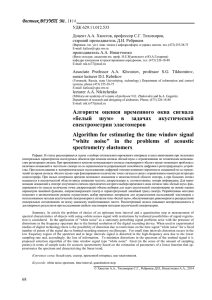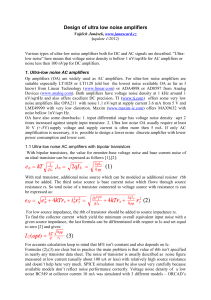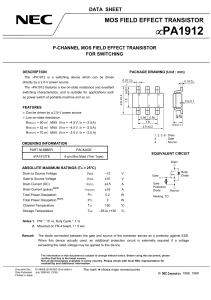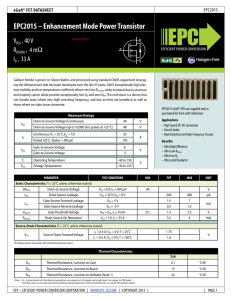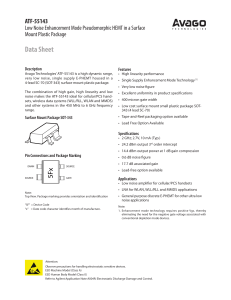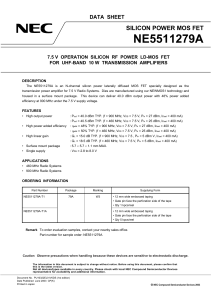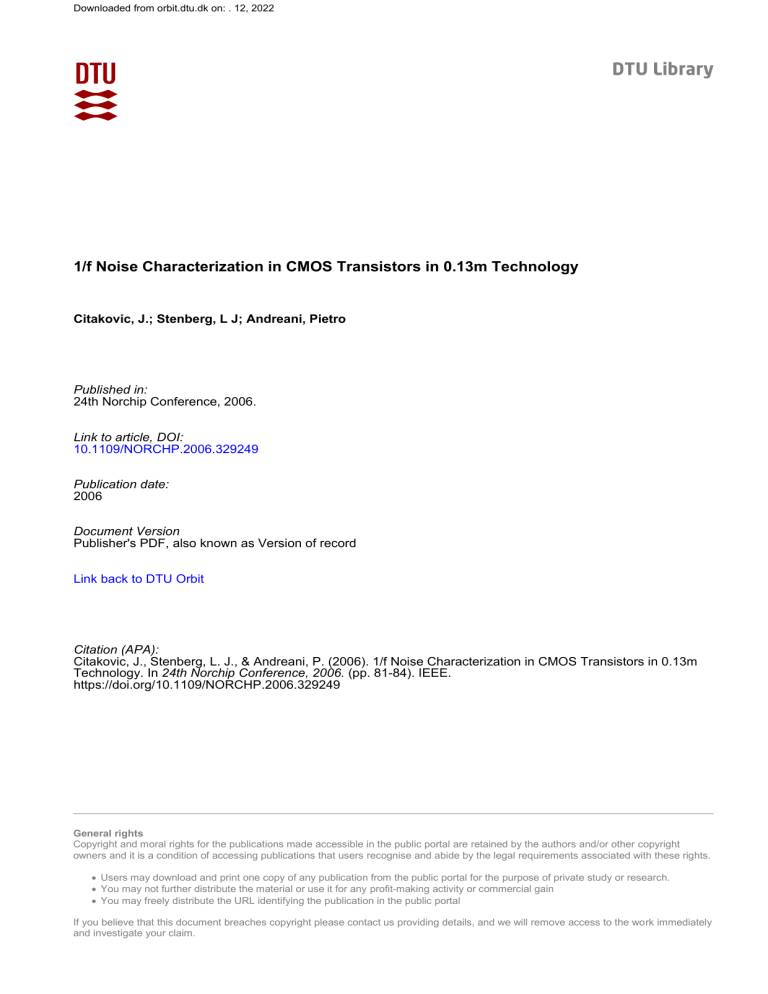
Downloaded from orbit.dtu.dk on: . 12, 2022 1/f Noise Characterization in CMOS Transistors in 0.13m Technology Citakovic, J.; Stenberg, L J; Andreani, Pietro Published in: 24th Norchip Conference, 2006. Link to article, DOI: 10.1109/NORCHP.2006.329249 Publication date: 2006 Document Version Publisher's PDF, also known as Version of record Link back to DTU Orbit Citation (APA): Citakovic, J., Stenberg, L. J., & Andreani, P. (2006). 1/f Noise Characterization in CMOS Transistors in 0.13m Technology. In 24th Norchip Conference, 2006. (pp. 81-84). IEEE. https://doi.org/10.1109/NORCHP.2006.329249 General rights Copyright and moral rights for the publications made accessible in the public portal are retained by the authors and/or other copyright owners and it is a condition of accessing publications that users recognise and abide by the legal requirements associated with these rights. Users may download and print one copy of any publication from the public portal for the purpose of private study or research. You may not further distribute the material or use it for any profit-making activity or commercial gain You may freely distribute the URL identifying the publication in the public portal If you believe that this document breaches copyright please contact us providing details, and we will remove access to the work immediately and investigate your claim. 1/f Noise Characterization in CMOS Transistors in 0.13,um Technology Jelena Citakovi 1'2, Lars J. Stenberg2 and Pietro Andreanil l0rsted-DTU, Technical University of Denmark DK-2800 Kgs. Lyngby, Denmark jhc @oersted.dtu.dk 2Sonion A/S, Byleddet 12-14, DK-4000 Roskilde, Denmark Abstract Low-frequency noise has been studied on a set of n- and p-channel CMOS transistors fabricated in a 0. 13um technology. Noise measurements have been performed on transistors with different gate lengths operating under wide bias conditions, ranging from weak to strong inversion. Noise origin has been identified for both type of devices, and the oxide trap density Nt, the Hooge parameter aH and the Coulomb scattering parameter a, have been extracted. The experimental results are compared with simulations using the BSIM3v3 MOS model. 2. Noise Models Two main theories are used to describe the origin of 1/f noise in MOS transistors. McWhorter carrier number fluctuations (AN) theory explains the noise origin by the fluctuations of the channel free carriers due to the random trapping and detrapping of charges in the oxide traps near the Si-SiO2 interface. Theoretical formulation for the drain current power spectral density SID, based on the AN theory proposed by Reimbold [7] and Van der Ziel [8] for transistors working in weak inversion, is given by q4Nt ID SID kTW=iYC2 T12 f 1. Introduction There is an increasing need for accurate low-noise circuits, as the technology-driven decrease in power supply voltage makes it increasingly difficult maintaining a high signal-to-noise ratio in modern analog designs. It is well known that a reduction in device size leads to an increased 1/f noise. In addition, as low-frequency noise is strongly technology dependent, novel processing steps introduced with technology downscaling lead to performance deviations which are difficult to predict [1]. To achieve an accurate prediction of the impact of 1/f noise on circuit performance, accurate noise modelling is required. Despite more than thirty years of research, a controversy still exists about the physical origin of 1/f noise in MOS transistors. Some authors attribute its origin to fluctuations in the total number of charge carriers [2], some to fluctuations in the mobility of carriers [3], and some to both [4]-[5]. The widely used BSIM3v3 MOS noise model implemented in commercially available circuit simulators is based on the latter approach [6]. In order to investigate the validity of noise models available to a circuit designer, in this work, a low frequency noise analysis is performed on n-channel and p-channel transistors biased both in weak and strong inversion, and both in linear and saturation regime. The noise measurement data are analyzed to identify the noise origin. The physical parameters Nt (oxide trap density), AH (Hooge parameter), and a, (Coulomb scattering parameter) have been extracted, and finally measurement data have been compared to simulations using BSIM3v3 noise model with noise parameters provided by the foundry. (1) where Nt is the trap density, -y (108/cm) is the tunnelling constant for the traps, and r is the weak inversion slope factor, given by (C,,+CD+Cit)IC0,, with C0X, CD and Cit being the oxide, depletion and interface trap capacitances per unit area, respectively (W, L, q, kT have their usual meaning). Experimental results in general show that the formalism (1) explains very well 1/f noise in weak inversion. In fact, the value of Nt can be extracted from noise measurements against drain current, if other parameters from (1) are known. Furthermore, this parameter is related to the BSIM noise parameter NOIA as Nt=NOIA/q. For transistors working in strong inversion in the ohmic range, the AN-based model of SID can be expressed by [9] q2kTNtQ2fHW VDS SID = y L3 f (2) with VDS being drain-source voltage and UeNf effective mobility. The second 1/f noise theory, Hooge mobility fluctuation (A,u) theory [3], explains the origin of 1/f noise by the fluctuations of bulk mobility with the empirical relation for homogeneous semiconductors, given by ID = SIDSAH Nf (3) where aH is Hooge parameter, constant for a given technology and N the total number of carriers under the gate. After estimation of N, it can be shown [9] that for a MOS transistor working in the linear region the following applies SID = CVHq,Pef f 3 (VGS -Vth) 1-4244-0772-9/06/$20.00 ©2006 IEEE Authorized licensed use lim ited to: D anm arks T ekniske Inform ationscenter. D ownloa de d on N ove m be r 2 8 , 2 0 0 9 a t 0 9 :2 9 from IE E E X plore . R e strictions a pply. (4) 81 The measured 1/f noise in n-MOS transistors in strong inversion in the ohmic region usually shows constant SIDI/,Uff versus gate bias voltage, in agreement with (2), which can not be predicted by the A,u model, because of the bias-independent aH; thus, the 1/f noise origin for ndevices is attributed to the number fluctuation theory. On the other hand, the observed dependence on the gate bias for the same region for p-channel transistors is following the A,u theory, in line with equation (4), and can not be explained by AN. However, quadratic variation of SID versus drain current, following the AN model described by (1), is observed for both n- and p-transistors in weak inversion, and can not be explained by the Hooge model. This controversy, known from the experiments published in the literature, has been observed in our experiments as well, which will be presented in the next section. Recent modelling efforts combine the two previously described approaches in the correlated number and mobility fluctuations AN-A,u model [4]-[5], in an attempt to come to a universal model valid for both n- and p-channel transistors in all operation regions. This model takes into account that the oxide/interface traps, apart from modulating the number of carriers, indirectly interact with the carrier mobility through Coulomb scattering. By this approach, the normalized drain current noise spectral density takes the form presented by Ghibaudo [5] [1 + S seff CoxID]2(M ) 2SVfb (5) ID where as is scattering parameter and SVfb is the flatband voltage spectral density given by q2 kTNt 1 SVfb -WLCO2 f (6) gm d Since for weak inversion gm q 1 ID kTr (7) and by neglecting the scattering term in (5), it can be noticed that g'n 2 SID D 2 ( -) SV D (8) equals equation (1). Similarly, by plugging in the formulas for leff and 'D in the linear region in (5), it can be shown that the input referred noise voltage density takes the form (9) Svg [1 + asOCox(VGSV Vth)] SVfb where /Jo is the low-field mobility and VGS the gate= - source voltage. The AN-A/J model described shows a satisfactory fitting to the experimental data for both p- and n-channel devices. However, critical discussions on its exactness exist [10]. A form of the unified model noise expression (5)-(9) is implemented in the BSIM3v3 circuit simulator model [6]. 3. Experimental Study 3.1. Measurement Set-Up The devices studied are fabricated in a 0.13,um CMOS technology with oxide thickness 2.4nm, n+/p+ poly gate, L (Qm) Vthn (V) Vthp (V) Sn (mV/dec) Sp(mV/dec) AL, (Qm) ALP (Qm) 0.13 0.41 0.365 86.23 96.32 I-On (cm2/Vs) AtOp (cm2/Vs) 0.26 0.395 0.364 84.97 87.62 0.5 0.372 0.353 84.19 91.66 0.01 0.015 221 60 0.360 0.349 95.7 92.6 2 0.336 97.05 Table 1: Extracted Transistor Conduction Parameters (W=10,um) for n- and p-MOS. shallow trench isolation and Co-silicided drain, source and gate. All the transistors tested have width W=10,um and different lengths. Transistors of the same type have common gate, source and bulk connections, and separate drains. Prior to noise measurements, DC characteristics ID(VGS) and gm(VGs) have been measured. From the DC characteristics for VDS=5OmV using the function ID as described in [11], the conduction parameters ,uo, Vth, AL and S (S=( d1j91D) dVGs 1 = 2.3kTq), ~~~q given in Table 1, have been extracted for both p- and n-transistors. The drain current noise of the tested devices has been amplified by a low-noise amplifier AD707JN connected in a transconductance configuration, and measured for different transistor bias voltages. The amplifier has been biased using batteries, while the variable voltage values supplied to the DUT have been generated from a PC using the N16289 high precision data acquisition card. The same card has been used for measurements with the noise spectra obtained with help of NI software. Lorentzian-like spectra usually observed on the top of 1/f noise for small area or minimum size devices have not been taken into account. The same noise behavior has been observed on three measured samples. 3.2. Results Discussion The plots of the normalized drain current power spectral density SID/12, and the corresponding (gYinID)2 ratio versus drain current are shown in Fig. 1 and Fig. 2 for n- and p-transistors respectively, working in the ohmic region. Analysis of these plots is considered a generic procedure to distinguish between the 1/f noise mechanisms. As explained by equations (5)-(8), if there is a good correlation of the normalized drain current noise with the corresponding transconductance to drain current ratio squared, the AN model dominates, which is clearly the case for our n-transistors. On the other hand, for p-transistors in Fig. 2, a departure from the (g",IID)2 characteristics in strong inversion can be explained by the influence of additional correlated mobility fluctuation. From the /1D2D weak inversion plateau, using the equation (1) and the slope factor value from Table 1, the Nt values are calculated. For both types of devices, the value of Nt is about 3.5 1017 -4.5. 1017(eV-lcm-3). The value of Nt for n-transistors in strong inversion matches the one for weak inversion. The input-referred noise power spectral density is plotted in Fig. 3 as a function of the effective gate-source volt- 82 Authorized licensed use lim ited to: D anm arks T ekniske Inform ationscenter. D ownloa de d on N ove m be r 2 8 , 2 0 0 9 a t 0 9 :2 9 from IE E E X plore . R e strictions a pply. IEEE Norchip 2006 110-~ 10 0 0 + . x . 0 ** 10- 10 10 x 10-7 10-D 10° 10 Id (A) 10- 0-10 L 10- 10-' 10- 10 Vgs-Vth (V) Figure 1: Normalized drain current noise SId /12 and (gm/ID)2 ratio of(-) versus drain current for VDS=5OmV for NMOS with various transistor lengths. L=0.26(L), 0.5 (x), 1 (e) and 2 (+),um. 10- Figure 3: Input referred noise Sv9 versus gate overdrive voltage for VDS=5OmV for various NMOS transistor lengths. Simulation (-), L=0.26(LII), 0.5 (x), 1 (e) and 2 (+) ,um. 10 10 , -LJ 10- d:p. X< x 10 - 10'L 10- 10 10 - Id (A) 10 lo-0 L 10 10 10 10 Vgs-Vth (V) Figure 2: Normalized drain current SId /1% noise and (gm/ID)2 ratio (-) versus drain current for VDS=5OmV for various PMOS transistor lengths. L=0.26(LII), 0.5 (x) and 1 (e) um. Figure 4: Input referred noise Sv9 versus gate overdrive voltage for VDS=5OmV for various PMOS transistor lengths. Simulation (-), L=0.26(LII), 0.5 (x) and 1 (e) (+) ,Pm. for n-transistors, and in Fig. 4 for p-transistors (VDS is 5OmV). From these figures, the noise origin observed in Fig. 1 and 2 can be confirmed by the fact that the input noise does not depend on VGS for n-channel transistors, while it is proportional to VGS-Vth for p-channel transistors as predicted by (2) and (4), respectively. In our experiments, the same origin has been confirmed by the plot of SID versus VGS, not shown here. The occasionally observed SID dependence on VGS for high overdrive voltages [12], due to the drain and source series resistances can not be observed for the relatively low bias voltages in Fig. 3. The solid lines in Fig. 3 and 4 are the results obtained by BSIM3v3 simulations. It can be seen that the simulator model predicts very well the noise of ptransistors, while discrepancies exist for the n-channel in linear region. The model predicts dependence on the gate bias similar to p-channel bias dependance. This might be due to the fact that for correct modelling when the AN model dominates, similarly to aH, the NOIB parameter should be proportional to (VGS- Vth)-l1 Besides that, it can be seen in Fig. 3 that the model provides different value of the flatband voltage, compared to the measured one. The mean value of aH for p-transistors with different dimensions is about 4.5. 10-4 This value is obtained from the measurement data by using a formula similar to (4) with SID expressed as a function of ID, VGS [9] that does not require the measurement of mobility attenuation factor 0. The values of a, for p-channel transistors, extracted using (9), have values 7.5 104- 9.5 104 (Vs/C). The values extracted are similar to the the values reported for the same technology node [13]. SID versus drain current for VDS=0.45V for various dimensions of p- and n-transistors is shown in Fig. 5 and 6, along with the simulated data. As expected, the drain current spectral density shows a quadratic dependence on the drain current in weak inversion for VDS=45OmV as well as for VDS=5OmV. As for the transistors working in linear region, measurements for p-channel transistors match very well simulations, while for n-transistors discrepancies are observed. The slope of the curve of SID versus age 1-4244-0772-9/06/$20.00 ©2006 IEEE Authorized licensed use lim ited to: D anm arks T ekniske Inform ationscenter. D ownloa de d on N ove m be r 2 8 , 2 0 0 9 a t 0 9 :2 9 from IE E E X plore . R e strictions a pply. 83 drain current is the same for measured and simulated data in Fig. 5 while the measured values are somehow greater than simulated. 5. Acknowledgments Noise study has been initiated and supported by Sonion A/S. Acknowledgments to Allan J0rgensen, DTU for IT and support with the test computer. 104 10-15 6. References 10 [1] E. Simeon and C. Claeys, "On the flicker noise in submicron silicon MOSFETs", Solid State Electronics, vol. 3, pp. 865882, 1999. ''10 10 [2] A. L. McWhorter, "Semiconductors surface physics", University ofPennsylvania Press, Philadelphia, USA, 1957. 0-10 v:210 10-2 10-7 [3] F N. Hooge, "1/f noise", Physica, vol. 83B, pp. 14-23, 1976. 10 106o Id (A) 10 10- Figure 5: Drain noise spectral density SID versus drain current for VDS=45OmV for various NMOS transistor lengths. Simulation (-), L=0.26(LII), 0.5 (x), 1 (e) and 2 (+) ,um. [4] K. K. Hung, P. K. Ko, C. Hu and Y. C. Cheng, "A unified model for the flicker noise in metal-oxide-semiconductor field effect transistor", IEEE Trans. Electron Devices, vol. 37, pp. 654-665, 1990. [5] G. Ghibaudo, 0. Roux, C. N. Duc, F. Balestra and J. Brini, "Improved analysis of low-frequency noise in field-effect MOS transistors", Physica of Status Solidi (A), vol. 124, pp. 571-581, 1991. [6] Y C. Cheng et al. "BSIM3v3 manual", Department of Electrical Engineering and Computer Sciences, University of California Berkeley, CA 94720 (1995). 10- lo-1 [7] G. Reimbold, "Modified 1/f trapping noise theory and experiments in MOS transistors biased from weak to strong inversion-influence of interface states ", IEEE Trans. Electron Devices, vol. ED-31, pp. 1190-1198, 1984. G 10 [8] A. Van der Ziel, "Noise in solid state devices and circuits", Wiley-Interscience, New York, USA, 1986. V)10 10-24 1-21 10' 10 10 Id (A) 10 10- Figure 6: Drain noise spectral density SID versus drain current for VDS=45OmV for various PMOS transistor lengths. Simulation (-), L=0.26(LII), 0.5 (x) and 1 (e) ,um. [9] M. Valenza, A. Hoffmann, D. Sodini, A. Laigle, F Martinez and D. Rigaud, "Overview of the impact of downscaling technology on 1/f noise in p-MOSFETs to 90nm", IEE Proc. -Circuits Devices Syst., vol. 151, pp. 102-110, 2004. [10] E. P. Vandamme and L. K. J. Vandamme, "Critical discussion on unified 1/f noise models for MOSFETs", IEEE Trans. Electron Devices, vol. 47, pp. 2146-2152, 2000. [11] G. Ghibaudo, "New method for the extraction of MOSFET parameters", Electronics Letters, vol. 24, pp. 543-545, 1988. [12] Y A. Allogo, M. Marin, M. de Murcia, P. Llinares and D. Cottin, "1/f noise in 0. 18,um technology n-MOSFETs from subthreshold to saturation", Solid-State Electronics, vol. 46, 4. Conclusion In this work, low frequency noise has been investigated on MOS transistors from 0. 13,um technology. It has been observed that the noise in n-transistors originates from the number fluctuation theory, while the noise in p-MOS is due to the number fluctuations with correlated mobility fluctuations. Values of the physical parameters extracted pp. 977-983, 2002. [13] M. Marin, Y A. Allogo, M. de Murcia, P. Llinares and J. C. Vildeuil, "Low frequency noise characterisation in 0.13,um p-MOSFETs. Impact of scaled-down 0.25, 0.18 and 0.13,um technologies on 1/f noise", Microelecronics Reliability, vol. 44, pp. 1077-1085, 2004. match well the values for similar technologies. The simulation result show very good match with the measured data for p-transistors, while some discrepancies for ntransistors are observed. 84 Authorized licensed use lim ited to: D anm arks T ekniske Inform ationscenter. D ownloa de d on N ove m be r 2 8 , 2 0 0 9 a t 0 9 :2 9 from IE E E X plore . R e strictions a pply. IEEE Norchip 2006
